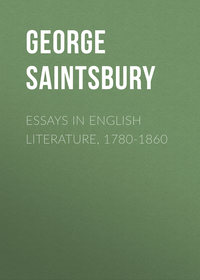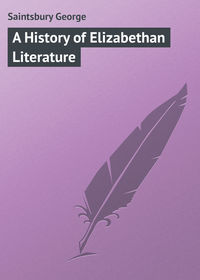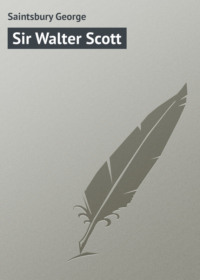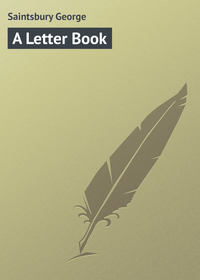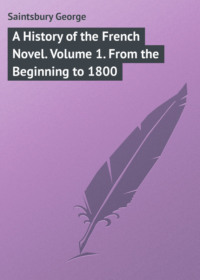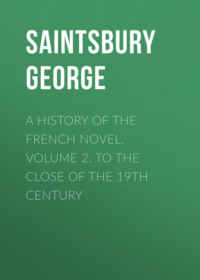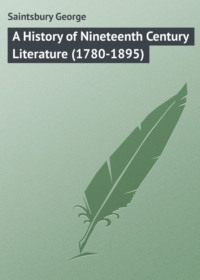 полная версия
полная версияA Short History of French Literature
Second Group of Romantic Poets.
Three distinct stages are perceptible in French poetry since the date of the Romantic movement, and we have now exhausted the remarkable names belonging to the first. Another opens with those poets who, being born in or about 1820, came to years of discretion in time to see the first force of the movement spent, and found the necessity of striking out something of a new way for themselves. Of this group three names stand pre-eminently forward, those of Baudelaire, Banville, and Leconte de Lisle, while some others may be mentioned beside them.
Théodore de Banville.
Théodore de Banville was born in 1820, of a good family, his father being an officer in the navy. He began to write very early with the Cariatides, and continued for fifty years to be active in prose and poetry. M. de Banville displayed at once a remarkable mastery of rhyme and rhythm, and it is in the exhibition of this that he chiefly excelled. Under his auspices not merely the graceful metrical systems of the Pléiade, but the older forms of the mediaeval poets, Ballades, Rondeaux, Triolets, etc., were once more brought into fashion. But M. de Banville was by no means only a clever versifier. His serious poetry (Cariatides, Stalactites, Odelettes, Les Exilé's, Trente-six Ballades) is full of poetical language and sentiment, his lighter verse (Occidentales, Odes Funambulesques) is charming, his prose is excellent, and he was no mean hand at drama (Gringoire).
Leconte de Lisle.
As M. de Banville sought for poetical novelty in an elaborate manipulation of the formal part of poetry, so M. Leconte de Lisle has sought it in a wide range of subject. He is a great translator of Greek verse. But in his original poems (Poésies Antiques, Poésies Barbares, Poëmes et Poésies) he has gone not merely to the classics but to the East and to mediaeval times for his inspiration. A tendency to load his verse with exotic names in unusual forms (he was one of the first Frenchmen to adopt the fashion of spelling Greek names with a strict transliteration) has brought, not perhaps altogether undeservedly, the charge of affectation on M. Leconte de Lisle. But he is a poet of no small power, not merely in outlandish subjects such as Le Massacre de Mona, Le Sommeil du Condor, Le Runoia, etc., but in much simpler work, such as the beautiful Requies.
Charles Baudelaire.
Charles Baudelaire had a more original talent than either of these. Although a very careful writer, he is not studious of bizarre rhythm, nor are his subjects for the most part outlandish. He chose, however, to illustrate a peculiar form of poetical melancholy by dwelling on subjects many of which would have been better left alone, while others were treated in a manner unsuited to the time. His Fleurs du Mal, therefore, as his chief work is entitled, had to undergo expurgation before it was allowed to be published, and has never been popular with the general public. But its best pieces, as well as the best of some singular Petits Poëmes en Prose, partly inspired by Louis Bertrand, have extraordinary merit in the way of delicate poetical suggestion and a lofty spiritualism. Baudelaire was also a very accomplished critic, his point of view being less exclusively French than that of almost any other French writer of the same class. He translated Poe and De Quincey.
Minor Poets of the Second Romantic Group.
Dupont.
The minor poets of this second Romantic school may again be grouped together. Charles Coran, a miscellaneous poet of talent, anticipated the school of which we shall shortly have to give some notice, that of the Parnassiens. Joséphin Soulary is remarkable for the extreme beauty of his sonnets, in devoting himself to which form he anticipated a general tendency of contemporary poets both English and French. Auguste Vacquerie, better known as a critic, a dramatist, and a journalist, began as a lyrical and miscellaneous poet, and achieved some noticeable work. Gustave Le Vavasseur attempted, not without success, to revive the vigorous tradition of Norman poetry. Pierre Dupont, better known than any of these, seemed at one time likely to be a poet of the first rank, but unfortunately wasted his talent in Bohemian dawdling and disorder. His songs were the delight of the young generation of 1848, and two of them, Le Chant des Ouvriers and Les Bœufs, are still most remarkable compositions. Louis Bouilhet (whose best poem is Melænis) has some resemblance to M. Leconte de Lisle, though he went still further afield for his subjects. He had no small power, but the defect of the old descriptive poetry revived in him, and in some of his contemporaries and followers, the defect necessarily attendant on forgetfulness of the fact that description by itself, however beautiful it may be, is not poetry. With these may be mentioned Gustave Nadaud, a song-writer pure and simple, free from almost any influence of school literature, a true follower of Béranger, though with much less range, wit, and depth.
The Parnasse.
Except Dupont and Nadaud, all the poets just mentioned may be said to belong more or less to the school of Gautier – the school, that is to say, which attached preponderant importance to form in poetry. Towards the middle of the Second Empire a crowd of younger writers, who had adopted this principle still more unhesitatingly, grew up, and formed what has been known for some years, partly seriously, partly in derision, as the Parnassien school. The origin of this term was the issue, in 1866 (as a sort of poetical manifesto preluding the great Exhibition of the next year), of a collection of poetry from the pens of a large number of poets, from Théophile Gautier and Emile Deschamps downwards. This was entitled Le Parnasse Contemporain, after an old French fashion. Another collection of the same kind was begun in 1869, interrupted by the war, and continued afterwards; and a third in 1876: while the Parnassien movement was also represented in several newspapers, the chief of which was La Renaissance. Another nickname of the poets of this sect (which, however, included almost all French writers of verse, even Victor de Laprade being counted in) was les impassibles, for their presumed devotion to art for art's sake, and their scorn of didactic, domestic, and sentimental poetry. Their numbers were very great, and none, save a few, can be mentioned here. Perhaps the chief of the original Parnassiens were MM. Sully Prudhomme and François Coppée, the former of whom experienced some reaction and affected what is called 'thoughtful verse,' while M. Coppée, having taken to domestic subjects, is as popular as any contemporary French poet, and in at least one instance (Le Luthier de Crémone) has achieved success at the theatre. A poet of great gifts, the latest of the vagabond school of Villon, was Albert Glatigny, who lived as a strolling actor, and died young. Many of his poems, but especially the Ballade des Enfans sans Souci, have singular force and pathos. It would hardly be fair to mention any other names, because a singular evenness of talent and general characteristics manifests itself among these poets. All sacrifice something to the perfection of form, or, to speak more correctly and critically, most are saved only by the perfection of their form, which is as a rule far superior to that of English minor poets. Of late years the Parnasse as a single group has broken up somewhat, and during the last decade some isolated poets of promise have appeared. M. Maurice Bouchor recurred to the bacchanalian model for inspiration; M. Paul Deroulède is tyrtaean and bellicose. Both of these may be said to be representative of reaction against the Parnasse. The new naturalist school, which has produced such singular work in prose fiction, is represented in poetry by M. Richepin and M. Guy de Maupassant. The former, with much unworthy work, produced in La Mer and elsewhere excellent things. The latter, despite an unfortunate licence of subject, showed himself the strongest and most accomplished versifier who has made his appearance in France for the last twenty years. But after his first efforts he appeared to abandon himself almost entirely to prose. M. Paul Verlaine, a poet known from the early days of the Parnasse, has more recently produced work of increased but very unequal merit, exaggerating the faults but showing some of the charm of Baudelaire; and, partly under his, partly under foreign influence, a still younger school has begun to make experiments in prosody which are not uninteresting, but which are too minute for notice here.
Minor and later Dramatists.
Scribe.
Ponsard.
Emile Augier.
Eugène Labiche.
Dumas the Younger.
Victorien Sardou.
The progress of French drama during the last half century is of somewhat less importance to literature, but of even more to social history, than that of poetry. The greatest masters of drama have already been mentioned among the eight typical names of 1830, even Balzac having attempted it, though without much success. The most famous and successful playwrights, however, as distinguished from the producers of literary dramas, have yet to be noticed293. Pixérécourt, a melodramatist and a book-collector, achieved his first success with a play on the well-known story of the Dog of Montargis (itself dating back to the earliest days of the Chansons de Gestes), in 1814, and followed it up with a long succession of similar pieces. Two years later Eugène Scribe, who had been born in 1791, made his début, as far as success goes, with Une Nuit de la Garde Nationale. Scribe was one of the most prolific, one of the most successful, and one of the least literary of French dramatists. For nearly half a century he continued, sometimes alone, and sometimes in collaboration, to pour forth vaudevilles, dramas, and comedies, almost all of which were favourably received. Scribe was generous to his associates, and would sometimes acknowledge the communication of a bare idea by a share in the profits of the play which it suggested. He had also an almost unrivalled knowledge of the technique of the theatre, and not a little wit. But his style is loose and careless, and his dramas do not bear reading. His most important later plays are Valérie, 1822; Le Mariage d'Argent, 1827; Bertrand et Raton, 1833; Le Verre d'Eau, 1840; Une Chaîne, 1841; Bataille de Dames, 1851. One of the less famous partakers in the first Romantic movement, Bouchardy, distinguished himself, in succession to Pixérécourt, as a Romantic melodramatist, his most famous works being Le Sonneur de Saint Paul, and Lazare le Pâtre. In 1843 a kind of reaction was supposed to be about to take place, the signs of which were the performance of the Lucrèce of Ponsard in that year, and of the Ciguë of Emile Augier the year after. Ponsard, however, was only a Romantic whose colour was deadened by his inability to attain more brilliant tones. His succeeding plays, Agnès de Méranie, Charlotte Corday, L'Honneur et l'Argent, showed this sufficiently. M. Emile Augier is a more remarkable and a more independent figure. In so far as he represents a protest against Romanticism at all (which he does only very partially), it is because he shared in the growing tendency towards realism, that is, to a recurrence in the Romantic sense to the tragédie bourgeoise of the preceding century, and because also he gave no countenance to the practice, in which some of the early Romantics indulged, of representing immoral personages as interesting. Almost all M. Augier's dramas, such as L'Aventurière, 1849, which is his masterpiece, Gabrielle, 1849, Diane, 1852, Le Mariage d'Olympe, 1855, Le Fils de Giboyer, 1862, and others of more recent date, are distinctly on the side of the angels. But the author does not make the excellence of his intention a reason for passing off inferior work, and he is justly recognised as one of the leaders of French drama in the latter half of the century. About this same time (1845) was the date of the appearance of a fertile and successful playwright of the less exalted class, M. Dennery (Don César de Bazan, L'Aieule). Auguste Maquet, another of the old guard of Romanticism, distinguished himself by helping to adapt to the stage the novels of Dumas the elder, which he had already helped to write; and one of his colleagues on Dumas' staff, M. Octave Feuillet, who was shortly to make a great reputation for himself as a novelist, appeared on the boards with Échec et Mat. During the whole of this decade (1840-1850) Delphine Gay, the beautiful and accomplished wife of the journalist Emile de Girardin, was a frequent and successful play-writer. Soon afterwards M. Legouvé, son of the academician of the same name, and himself an academician, began to collaborate with Scribe in works of more importance (Adrienne Lecouvreur) than the latter had before attempted; while George Sand and her former friend, Jules Sandeau, were also drawn into the inevitable theatrical vortex. In collaboration with Augier, Sandeau produced, from one of his own novels, one of the best plays of the century, Le Gendre de M. Poirier, 1855. Eugène Labiche, who had been born in 1815, distinguished himself, in 1851, by Le Chapeau de Paille d'Italie, and in it laid the foundation of a long career of success in the lighter kind of play which, at last, conducted him to the Academy. His best-known play is Le Voyage de M. Perrichon. The year 1852 was memorable for the French stage, for it saw the production of La Dame aux Camélias, the first important play of Alexandre Dumas fils. Without much of his father's talent for novel-writing, M. Dumas has been both a more successful, and perhaps a better, dramatist. Most of his plays have been directed to some burning question of the social or ethical kind, and it has been his practice to re-issue them after a time, with argumentative prefaces, in a very singular style. Diane de Lys, Le Demi-Monde, La Question d'Argent, Le Fils Naturel, Le Supplice d'une Femme (nominally composed with Emile de Girardin), Les Idées de Madame Aubray, Une Visite de Noces, and L'Étrangère, are his chief works. In 1854 appeared a now almost forgotten work by Victorien Sardou, who was destined to be the favourite dramatist of the Second Empire, and to share with MM. Augier and Dumas fils the chief rank among the dramatists of the last half of the century. Seven years later Nos Intimes gave him a great success, and, in 1865, La Famille Benoiton a greater, which he followed up with Nos Bons Villageois, 1866. Since that time he has written many plays, of which the finest by far, and one of the few comedies of this age likely to become classical, is the admirable Rabagas– a satire of the keenest on the interested politicians, who, in France as elsewhere, take up demagogy as a trade. M. Sardou has attempted serious work in various plays, the best of which is, perhaps, Patrie, but it is not his forte. Satirical observation of manners, and especially of the current political and social follies of the day, is what he can do best, and in this peculiar line he has few equals. But he is admitted to be one of the most unequal of writers. A peculiar offspring of the Second Empire are the brilliant burlesques of Offenbach, which owed at least part of their brilliancy to the librettos composed for them by MM. Meilhac and Halévy. The first-named of these had produced successful dramas as far back as 1859. The collaborateurs did not confine themselves to furnishing words for M. Offenbach's music, but attempted the prose drama frequently and with success, Froufrou being their most important work in this way. M. Gondinet and M. Pailleron also deserve notice as successful manufacturers of light plays, the latter in especial having an excellent wit (Le monde où l'on s'ennuie, Le Chevalier Trumeau). This may also be asserted of M. Halévy, who has latterly, in Les Petites Cardinal and other non-dramatic sketches, shown himself to even greater advantage than on the stage. Indeed the Cardinal family may be said to be the most striking literary creation of its kind for years.
In a different class and earlier, Joseph Autran, a poet of the school of Lamartine, obtained a great reputation by his tragedy of La Fille d'Eschyle, which procured him a seat in the Academy, and gave him the opportunity of writing not a few volumes of polished, but not very vigorous, poetry. M. Théodore de Banville, who has tried most paths in literature, produced, in 1866, a short play, with the old mystery-writer Gringoire for hero and title-giver; a play which is admirably written, and which has kept its place on the stage. M. François Coppée's graceful Luthier de Crémone has already been mentioned. Another literary dramatist, to distinguish the class from those who are playwrights first of all, is M. Henri de Bornier, who obtained some success, in 1875, with La Fille de Roland, and, in 1880, with Les Noces d'Attila. Both these are good, though not consummate, specimens of the poetical drama.
Classes of Nineteenth-Century Fiction.
Active, however, as was the cultivation of poetry proper and of the drama, it is not likely that the nineteenth century will be principally known in French literary history either as a poetical, or as a dramatic age. Its most creative production is in the field of prose fiction. It is particularly noteworthy that every one of the eight names which have been set at its head is the name of a novelist, and that the energy of most of these authors in novel-writing has been very considerable. Their production may be divided into two broad classes – novels of incident, of which Hugo and Dumas were the chief practitioners, and which derive chiefly from Sir Walter Scott; and novels of character, which, with a not inconsiderable admixture of English influence, may be said to be legitimately descended from the indigenous novel created by Madame de la Fayette, continued by Marivaux and still more by Prévost, and maintained, though in diminished vivacity, by later writers. Of this school George Sand and Balzac are the masters, though much importance must also be assigned to Stendhal. At first the novelists of 1830 decidedly preferred the novel of incident, the literary success of which in the hands of Hugo, and its pecuniary success in the hands of Dumas, were equally likely to excite ambitions of different kinds.
Minor and later Novelists.
Jules Janin.
A rival of both of these in popularity during the reign of Louis Philippe, though infinitely inferior to both in literary skill, was Eugène Sue. With him may be classed another voluminous manufacturer of exciting stories, Frédéric Soulié, and somewhat later Paul Féval, with next to them Amédée Achard and Roger de Beauvoir. A better writer than any of these was Jules Janin, whose literary career was long and prosperous, but not uniform. Janin began with a strange story, in the extremest Romantic taste, called L'Ane Mort et la Femme Guillotinée. This at a later period he represented as an intentional caricature, which is not on the whole likely. He followed it up with Barnave, a historical novel full of exciting incident. Both these books, however, with grave defects, have power perhaps superior to that shown in anything that Janin did later. Being an exceedingly facile writer, and lacking that peculiar quality of style which sometimes precludes popularity with the many as much as it secures it with the few, he became absorbed in journalism, in the furnishing of miscellaneous articles, prefaces, and so forth, to the booksellers, and finally in theatrical criticism, where he reigned supreme for many years. None of his later novels need remark. With Janin may be mentioned M. Alphonse Karr, who however has been more of a journalist than of a novelist. His abundant and lively work has not perhaps the qualities of permanence. But his Voyage autour de mon Jardin, his Sous les Tilleuls, and the satirical publication known as Les Guépes, deserve at least to be named. Here too may be noticed M. Barbey d'Aurévilly whose works critical and fictitious (the chief being probably L'Ensorcelée) display a very remarkable faculty of style, perhaps too deliberately eccentric, but full of distinction and vigour.
Under the Empire, a fresh group of novelists of incident sprang up. MM. Erckmann and Chatrian produced in collaboration a large number of tales, chiefly dealing with the events of the Revolution and the First Empire in the north-eastern provinces of France. Criminal and legal subjects were great favourites with the late Emile Gaboriau, who naturalised in France the detective novel. His chief follower is M. Fortuné du Boisgobey.
Charles de Bernard.
The best novelists of the generation of 1830, outside the list of masters, have yet to be noticed. These are Charles de Bernard and Jules Sandeau. Charles de Bernard was at one time Balzac's secretary, but his fashion of work is entirely different from that of his employer. He divides himself for the most part between the representation of the Parisian life of good society and that of country-house manners. His shorter tales are perhaps his best, and many of them, such as L'Ecueil, La Quarantaine, Le Paratonnerre, Le Gendre, etc., are admirable examples of a class in which Frenchmen have always excelled. But his longer works, Gerfaut, Les Ailes d'Icare, Un Homme Sérieux, etc., are not inferior to them in wit, in accurate knowledge and skilful portraiture of character, in good breeding, and in satiric touches which are always good-humoured.
Jules Sandeau.
Jules Sandeau was a novelist of no very different class, but with less wit, with much less satiric intention, and with a greater infusion of sentiment, not to say tragedy. His best novels, Catherine, Mademoiselle de Penarvan, Mademoiselle de la Seiglière, Le Docteur Herbeau, are drawn from provincial life, which, from the great size of France and its diversity in scenery and local character, has been a remarkably fertile subject to French novelists. These novels are remarkable for their accurate and dramatic construction (which is such that they have lent themselves in more than one instance to theatrical adaptation with great success) and their pure and healthy morality.
Octave Feuillet.
Murger.
Edmond About.
Feydeau.
Gustave Droz
Next in order of birth may be mentioned Octave Feuillet, who began, as has been mentioned, by officiating as assistant to Alexandre Dumas. His first independent efforts in novel-writing, Bellah and Onesta, were of the same kind as his master's; but they were not great successes, and after a short time he struck into an original and much more promising path. His first really characteristic novel was La Petite Comtesse, 1856, and this was followed by others, the best of which are Le Roman d'un Jeune Homme Pauvre, 1858; Sibylle, 1862; M. de Camors, 1867; and Julia de Trécœur, 1872: the two last being perhaps his strongest books, though the Roman d'un Jeune Homme Pauvre is the most popular. M. Feuillet wrote in a pure and easy style, and exhibited in his novels acquaintance with the manners of good society, and a considerable command of pathos. He was more studious of the proprieties than most of his contemporaries, but has indulged in a somewhat unhealthy sentimentalism. Henry Murger had a very original, though a somewhat limited, talent. He is the novelist of what is called the Parisian Bohême, the reckless society of young artists and men of letters, which has always grouped itself in greater numbers at Paris than anywhere else. The novel, or rather the series of sketches, entitled La Vie de Bohême is one which, from the truth to nature, the pathos, and the wit which accompany its caricature and burlesque of manners, will always hold a position in literature. Murger, who experienced many hardships in his youth, was all his life a careless and reckless liver, and died young. His works (all prose fiction, except a small collection of poems not very striking in form but touching and sincere in sentiment) are tolerably numerous, but the best of them are little more than repetitions of the Vie de Bohême. Edmond About, a very lively writer, whose liveliness was not always kept sufficiently in check by good taste, oscillated between fiction and journalism, latterly inclining chiefly to journalism. In his younger days he was better known as a novelist, and some of his works, such as Tolla and Le Roi des Montagnes, were very popular. More characteristic perhaps are his shorter and more familiar stories (L'Homme à l'Oreille Cassée, Le Nez d'un Notaire, etc.). In this same group of novelists of the Second Republic and Empire ranks Ernest Feydeau, a morbid and thoroughly unwholesome author, who, however, did not lack power, and once at least (in Sylvie) produced work of unquestionable merit. His other novels, Fanny, Daniel, La Comtesse de Chalis, are chiefly remarkable as showing the worst side of the society of the Empire. Among writers of short stories Champfleury, a friend and contemporary of Murger (who has more recently betaken himself to artistic criticism of the historical kind), deserves notice for his amusing extravaganzas, and Gustave Droz for the singularly ingenious and witty series of domestic sketches entitled Monsieur, Madame et Bébé, and Entre Nous. The range of subject in these is wide and not always what is understood by the English word domestic. But the fancy shown in their design and the literary skill of their execution are alike remarkable and worthy of the ancient reputation of France in the short prose tale. Nor have they lacked followers.




